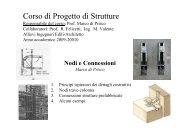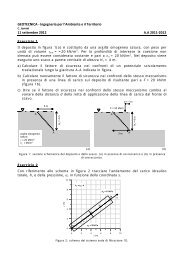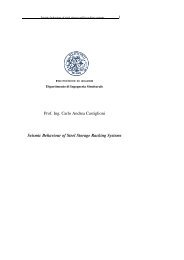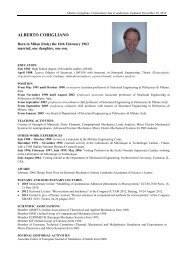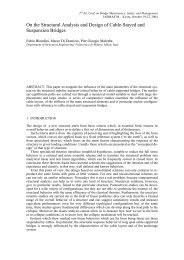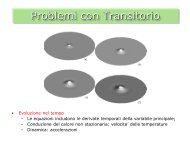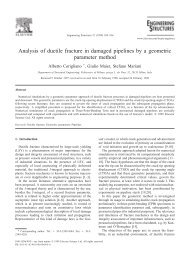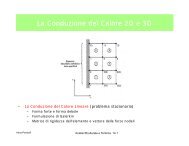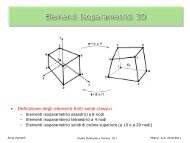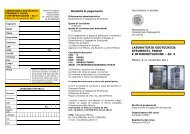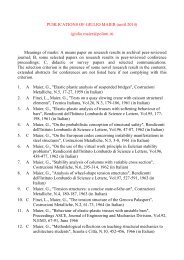a three-dimensional finite beam element for multiscale damage ...
a three-dimensional finite beam element for multiscale damage ...
a three-dimensional finite beam element for multiscale damage ...
- No tags were found...
You also want an ePaper? Increase the reach of your titles
YUMPU automatically turns print PDFs into web optimized ePapers that Google loves.
Table 1. Limit points of the cyclic constitutive law of concrete.rε1ε1 = max ε ε ∈ Iσ1=rr −1+ε1σ1ε2= ε1− ( ε1+ εa)σ 0σ + E ε2=1 { }233ε1410aε = σ3= 0.92σ1+ 0.08σR≥ 0. 92σ1σ1−σ3rε4ε4= ε1+ ( 2 + k)σ4=rr −1+εE R5 ε = min{ ε ε ∈ }5I⎧ϕEσ5 ⎨⎩σcrσ 6=6 ε 6= ε 5− εt0= last ε ∆ε< 0σ U= σ ( ε UU { }R = last { ε ∆ε> 0 }ε U)ε Rσ = σ ε )R4( ε − ε )=∗( R[ − λ ( ε − ε )]0 5 2{(1−α)exp+ α}5cr, εcr≤ ε5≤ ε2, ε < ε1. Point of maximum strain ε on the envelope curve I .2. Point of transition between compression and tension.3. Point of reloading in the elastic phase.4. Point of return on the branch in compression of the envelope curve I .5. Point of minimum strain ε on the envelope curve I .6. Point of transition between compression and tension.U. Point of last unloading with ∆ε < 0 .R. Point of last reloading with ∆ε > 0 .ε =⎧ 1aa ε 1= ⎨ ; 0.091⎩1+⎭ ⎬⎫ σ3−σR1a maxε E R=εcr= ε 2+ ε tσ cr= ϕσtϕ =4ε1ε3− εR1+0.3ε1For the rein<strong>for</strong>cing steel, the cyclic constitutive law refers to the models developed by Goldberg andRichard (1963), Giuffrè and Pinto (1970), Menegotto and Pinto (1973), Monti and Nuti (1992). Details ofits implementation can be found in Biondini (2000). Here it is only recalled that such law accounts <strong>for</strong>yielding, kinematic-isotropic hardening, saturation and memory of the plastic strains, buckling of the bars.Numerical Integration of the Finite Element CharacteristicsThe quantities which define the characteristics of the <strong>finite</strong> <strong>element</strong> are evaluated by numerical integration.To this aim, the volume of the <strong>element</strong> is subdivided in isoparametric sub-domains having quadrilateralcross-sections, and each sub-domain is replaced by a grid of points which location depends on the adoptedintegration rule (Bontempi et al. 1996). In particular, depending on the function to be integrated and thegeometry of the problem, the Gauss-Legendre and the Gauss-Lobatto schemes are used (Figure 4).Dynamic Equilibrium Equations of the StructureThe equilibrium conditions of the <strong>finite</strong> <strong>beam</strong> <strong>element</strong> are derived from the already mentioned principle ofvirtual work. In this way, by assembling the <strong>element</strong> contributions with reference to a global coordinatesystem, the incremental dynamic equilibrium of the whole structure can be <strong>for</strong>mally expressed as follows:M d & s+ C ds&+ K ds= df(8)where s is the vector of the nodal displacements and f = f 0 +f 1 +f g is the vector of the nodal <strong>for</strong>ces. The latterresults from the nodal loads f 0 , the nodal <strong>for</strong>ces f 1 equivalent to the <strong>element</strong> loads f a = f a (x′), and the nodal<strong>for</strong>ces f g = −ü g Mi equivalent to the seismic actions due to the non-inertial acceleration ü g =ü g (t) of theground, and where i is the influence vector which components represent the nodal displacements <strong>for</strong> thestatic application of a unit ground displacement u g =1. Finally, the damping matrix C=C(t) is obtained ateach time instant from the modal properties of the structure according to the Rayleigh's model.5cr




